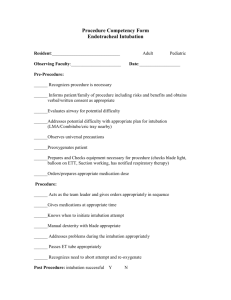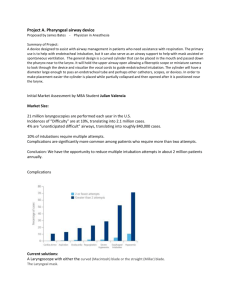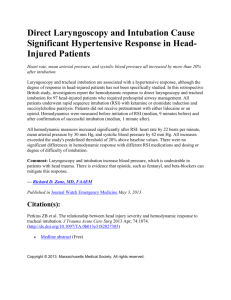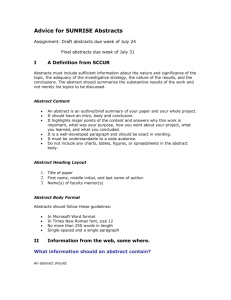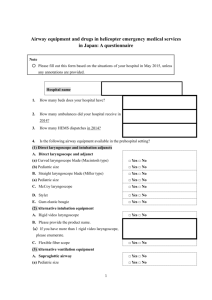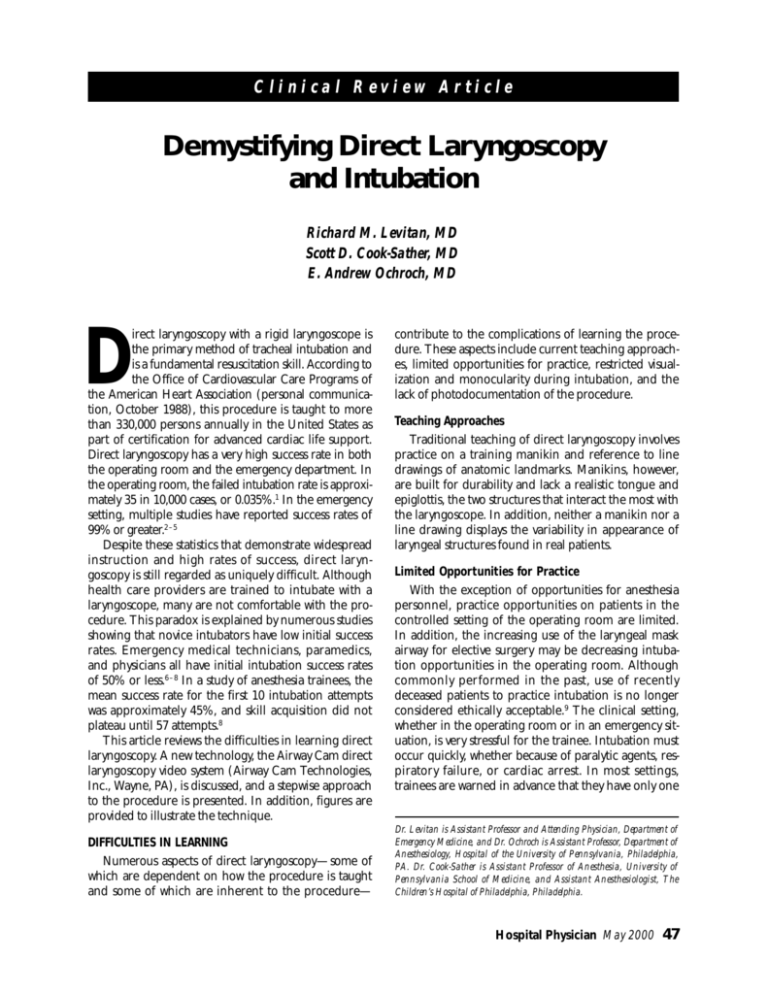
Clinical Review Article
Demystifying Direct Laryngoscopy
and Intubation
Richard M. Levitan, MD
Scott D. Cook-Sather, MD
E. Andrew Ochroch, MD
irect laryngoscopy with a rigid laryngoscope is
the primary method of tracheal intubation and
is a fundamental resuscitation skill. According to
the Office of Cardiovascular Care Programs of
the American Heart Association (personal communication, October 1988), this procedure is taught to more
than 330,000 persons annually in the United States as
part of certification for advanced cardiac life support.
Direct laryngoscopy has a very high success rate in both
the operating room and the emergency department. In
the operating room, the failed intubation rate is approximately 35 in 10,000 cases, or 0.035%.1 In the emergency
setting, multiple studies have reported success rates of
99% or greater.2–5
Despite these statistics that demonstrate widespread
instruction and high rates of success, direct laryngoscopy is still regarded as uniquely difficult. Although
health care providers are trained to intubate with a
laryngoscope, many are not comfortable with the procedure. This paradox is explained by numerous studies
showing that novice intubators have low initial success
rates. Emergency medical technicians, paramedics,
and physicians all have initial intubation success rates
of 50% or less.6 – 8 In a study of anesthesia trainees, the
mean success rate for the first 10 intubation attempts
was approximately 45%, and skill acquisition did not
plateau until 57 attempts.8
This article reviews the difficulties in learning direct
laryngoscopy. A new technology, the Airway Cam direct
laryngoscopy video system (Airway Cam Technologies,
Inc., Wayne, PA), is discussed, and a stepwise approach
to the procedure is presented. In addition, figures are
provided to illustrate the technique.
D
DIFFICULTIES IN LEARNING
Numerous aspects of direct laryngoscopy—some of
which are dependent on how the procedure is taught
and some of which are inherent to the procedure—
contribute to the complications of learning the procedure. These aspects include current teaching approaches, limited opportunities for practice, restricted visualization and monocularity during intubation, and the
lack of photodocumentation of the procedure.
Teaching Approaches
Traditional teaching of direct laryngoscopy involves
practice on a training manikin and reference to line
drawings of anatomic landmarks. Manikins, however,
are built for durability and lack a realistic tongue and
epiglottis, the two structures that interact the most with
the laryngoscope. In addition, neither a manikin nor a
line drawing displays the variability in appearance of
laryngeal structures found in real patients.
Limited Opportunities for Practice
With the exception of opportunities for anesthesia
personnel, practice opportunities on patients in the
controlled setting of the operating room are limited.
In addition, the increasing use of the laryngeal mask
airway for elective surgery may be decreasing intubation opportunities in the operating room. Although
commonly performed in the past, use of recently
deceased patients to practice intubation is no longer
considered ethically acceptable.9 The clinical setting,
whether in the operating room or in an emergency situation, is very stressful for the trainee. Intubation must
occur quickly, whether because of paralytic agents, respiratory failure, or cardiac arrest. In most settings,
trainees are warned in advance that they have only one
Dr. Levitan is Assistant Professor and Attending Physician, Department of
Emergency Medicine, and Dr. Ochroch is Assistant Professor, Department of
Anesthesiology, Hospital of the University of Pennsylvania, Philadelphia,
PA. Dr. Cook-Sather is Assistant Professor of Anesthesia, University of
Pennsylvania School of Medicine, and Assistant Anesthesiologist, The
Children’s Hospital of Philadelphia, Philadelphia.
Hospital Physician May 2000
47
Levitan et al : Direct Laryngoscopy : pp. 47–56,59
Epiglottis
False
vocal
cord
True vocal
cords
Epiglottic
tubercle
False
vocal cord
True
vocal
cords
Posterior
cartilages
False
vocal
cord
Posterior
cartilage
False
vocal
cord
Figure 1. Fiberoptic view of the larynx through a diagnostic
rhinolaryngoscope.The epiglottis is apparent at the top of the
image, but the edge of the epiglottis is not visible. At the base
of the epiglottis is the epiglottic tubercle. Coming down from
the epiglottis to the posterior cartilages are the aryepiglottic
folds.The difference between the true vocal cords (vocal ligaments) and false vocal cords (vocal folds) is apparent. Figure
courtesy of Richard M. Levitan, MD. Reprinted with permission from Airway Cam Technologies, Inc.,Wayne, PA.
Figure 2. View of the larynx as seen with a stroboscopic rigid
laryngoscope.This view of the larynx is upside down compared
with the view during direct laryngoscopy. At the top of the
image, the tracheal rings can be seen between the posterior
cartilages.The true and false vocal cords are also shown. Figure
courtesy of Richard M. Levitan, MD. Reprinted with permission
from Airway Cam Technologies, Inc.,Wayne, PA.
opportunity for intubation before a supervisor performs the procedure.
The monocularity of laryngoscopy means that the
procedure cannot be effectively observed over someone else’s shoulder. A supervisor cannot provide targeted feedback to a trainee because they both cannot
simultaneously visualize the laryngeal structures.
Likewise, if the trainee fails, the supervisor cannot
effectively demonstrate the procedure to the trainee.
Restricted Visualization and Monocularity
The inherently difficult aspect of direct laryngoscopy is that the procedure is visually analogous to
looking down a narrow pipe at a target the size of a
quarter. The opening of the mouth, the tongue,
epiglottis, and laryngoscope blade all interact to
restrict visualization of the larynx to the dominant
pupil. Procedural texts teach that a binocular view of
the larynx can be achieved by keeping the left arm
straight and maintaining a relatively far distance away
from the patient’s mouth.10,11 Although most laryngoscopists keep both eyes open during the procedure,
when the visual input from each eye is alternatively
restricted, the monocular nature of the procedure can
be appreciated.12 Four out of five persons use the right
eye to sight the larynx during laryngoscopy.12 This statistic reflects the facts that eyedness follows handedness
and 80% to 90% of persons are right handed. Also, the
common laryngoscope designs (Macintosh, Miller, and
Wisconsin) all have a left- sided flange for directing the
tongue leftward. The resultant view down the mouth is
along the right paralingual space. Persons with glasses
and left-hand dominance are more likely to use their
left eye to sight the larynx.12
48 Hospital Physician May 2000
Lack of Photodocumentation
In addition to the multiple factors already discussed
that complicate learning laryngoscopy, one final aspect
must be noted: the procedure has not been traditionally photodocumented from the perspective of the laryngoscopist. No photographs of the procedure as it
appears to the laryngoscopist are available in any resuscitation, anesthesia, or emergency medicine reference
texts. Diagnostic imaging of the larynx is routinely performed with sophisticated stroboscopic laryngoscopes
and flexible fiberoptic devices, but these images do not
correlate with what is actually seen during direct laryngoscopy (Figures 1 and 2). In direct laryngoscopy, not
only is the view more restricted, but the structures are
smaller and upward traction on the laryngoscope
blade distorts laryngeal anatomy.
Proposed Solutions
To address some of the teaching and supervisory
Levitan et al : Direct Laryngoscopy : pp. 47–56,59
Front view
Side view
Attachment point to headset
with vertical and horizontal
adjustment mechanism
Miniature videocamera,
vertically positioned
within camera tube,
with adjustable
focus ring
Laryngoscopist’s view (double dashed
line), and twice-reflected target image
(single dashed line) directed to camera
Beam-splitting pentaprism wedge assembly
Figure 3. Optical path of the Airway Cam direct laryngoscopy video system. Figure courtesy of Airway Cam Technologies, Inc.,
Wayne, PA.
challenges of direct laryngoscopy, several authors have
proposed attaching a fiberoptic scope to a rigid laryngoscope blade.13,14 This solution, however, results in an
intra- oral fiberoptic view of the larynx and does not correlate with what the laryngoscopist sees. Head-mounted
cameras, positioned between the eyes, are commonly
used in major teaching hospitals to display surgical procedures but these cameras do not work for laryngoscopy
because of the monocularity of the procedure.
THE AIRWAY CAM
The Airway Cam direct laryngoscopy video system,
invented in 1994, is a head-mounted video device with
a monocular sighting mechanism that can image the
procedure of direct laryngoscopy from start to finish.15
The original design used a standard pentaprism that
was attached to a vertically mounted miniature video
camera on a pair of goggles. A pentaprism was used to
reflect the target image through two reflections, thus
correcting the left-right orientation for the camera.
The design has been modified recently with a beamsplitting pentaprism wedge assembly, and the device is
now mounted to an adjustable headset.16 The optical
path of this device is shown in Figure 3. The beamsplitting prism allows the laryngoscopist to sight directly through the prism at the target, as shown in Figure 4.
The video signal can be displayed on a monitor for
real-time display as well as recorded.
The device can be worn by the trainee to demonstrate to the supervisor what exactly the trainee is seeing.17,18 This system allows targeted feedback and
enables the supervisor to perform minor interventions
to assist the trainee without taking over the procedure.
Examples of these interventions include retracting the
upper right lip, manipulating the external larynx, and
providing additional upward leverage on the laryngoscope. With the use of telemedicine technology and
long-range transmission, visual observation and two-way
audio communication can occur off site.19 For students
and other trainees rotating through the operating
room, the system allows them to effectively observe the
procedure. For paramedics, residents, or nurse practitioners, in whom documentation of airway management skills is required, the device allows them to record
all of their intubation attempts, and the resultant videotape can serve as a visual record of basic competence.
As of April 1999, 10 Airway Cam systems were in use
in the United States, and three commercially available
videotapes have been made with the device.20 –23 In the
future, a large library of direct laryngoscopy images will
be available through videotapes, compact disks, and
print media as well as the Internet. The authors of this
article expect that photodocumentation of intubation
will become as routine a part of training as a manikin is
currently.
A STEPWISE APPROACH
The following steps to direct laryngoscopy and intubation apply to patients who are deeply comatose or in
cardiac arrest (Table 1). The steps of laryngoscopy as
mentioned omit the use of pharmacologic adjuncts.
The Airway Cam device can be used to image any laryngoscopy, but patients who are not deeply comatose or
in cardiac arrest may not have relaxed jaws and may bite
Hospital Physician May 2000
49
Levitan et al : Direct Laryngoscopy : pp. 47–56,59
Figure 4. Photograph of the Airway Cam direct laryngoscopy imaging system seen from the lateral perspective during laryngoscopy. Note the alignment of the operator’s eye, the camera, and the target. Inset) The larynx as seen during direct laryngoscopy with a Wisconsin blade. Reprinted with permission from Airway Cam Technologies, Inc.,Wayne, PA.
Table 1. Steps for Direct Laryngoscopy and Intubation
Preparation (SOAPME)
Suction
Oxygen
Airway equipment (tracheal tube, oral airway, laryngoscope)
Positioning and pre-oxygenation
Monitors (cardiac monitor and pulse oximetry)
Esophageal detection device (end-tidal carbon dioxide
detector, esophageal bulb, or syringe aspiration device)
Proper positioning of the patient
Opening the patient’s mouth
Control of the tongue
Control of the epiglottis
Landmark identification
Passage of the tracheal tube
commonly used by anesthesiologists and emergency
physicians, these agents are not appropriate for use by
novice intubators and are beyond the scope of this article. The process of direct laryngoscopy and intubation
as seen using the Airway Cam is illustrated in Figures 5
and 6.
Preparation
Prior to beginning the procedure, the proper equipment must be assembled. A mnemonic for remembering the necessary equipment is SOAPME:
S = suction
O = oxygen
A = airway equipment (tracheal tube, oral airway,
laryngoscope)
P = positioning and pre- oxygenation
M= monitors (cardiac monitor and pulse oximetry)
as the intubator’s fingers are inserted in the patient’s
mouth. (The Airway Cam does not assist intubation—
this device solely enables imaging and supervision.)
Although induction agents and muscle relaxants are
50 Hospital Physician May 2000
E = esophageal detection device (end-tidal carbon
dioxide [CO2] detector, esophageal bulb, or
syringe aspiration device)
The laryngoscope light should be checked before use,
and the cuff on the tracheal tube should be inflated,
Levitan et al : Direct Laryngoscopy : pp. 47–56,59
A
B
C
D
E
F
Figure 5. Intubation sequence using a Wisconsin 2 blade in a 6-year-old child. A) The scissor technique is used to open the
mouth, B) the posterior pharynx is visualized, C) the edge of the epiglottis and the hypertrophied tonsils are seen, D) the posterior cartilages and a portion of the glottis are visible but the vocal cords are not seen, E) the true vocal cords, glottic opening,
and posterior cartilages are visualized, and F) a cuffless tracheal tube is inserted from the right side. Figure courtesy of Scott D.
Cook-Sather, MD. Reprinted with permission from Airway Cam Technologies, Inc.,Wayne, PA.
Hospital Physician May 2000
51
Levitan et al : Direct Laryngoscopy : pp. 47–56,59
A
B
C
D
E
F
Figure 6. Intubation sequence using a modified Macintosh blade in a young woman. A) The scissor technique is used to open
the mouth, B) the uvula and posterior pharynx are visualized, C) the brightly lit edge of the epiglottis comes into view, D) the
glottis with the epiglottis elevated indirectly by the tip of the curved blade is visualized, E) further lifting with the laryngoscope
blade elevates the epiglottis out of view, and F) a cuffed tracheal tube is inserted from the right side. Figure courtesy of
E. Andrew Ochroch, MD. Reprinted with permission from Airway Cam Technologies, Inc.,Wayne, PA.
52 Hospital Physician May 2000
Levitan et al : Direct Laryngoscopy : pp. 47–56,59
A
Figure 7. Ideal head positioning for laryngoscopy on an adult
patient involves slight head elevation (neck flexion) and
extreme atlanto-occipital extension. Figure courtesy of Richard
M. Levitan, MD. Reprinted with permission from Airway Cam
Technologies, Inc.,Wayne, PA.
checked for leaks, and fully deflated. A malleable
stylet, fashioned in the shape of a hockey stick, is generally recommended for emergency cases. The stylet
should never extend beyond the tip of the tracheal
tube.
Proper Positioning of the Patient
Failure to properly position the patient is a common mistake of novice intubators. Direct laryngoscopy
involves direct sighting of the larynx by displacing the
tongue and epiglottis with the laryngoscope. Achieving
this goal requires alignment of the oropharyngeal,
pharyngeal, and laryngeal axes. Atlanto - occipital
extension and slight neck flexion is the ideal position
for alignment of the axes. This position is possible to
attain by elevating the patient’s head 8 to 10 cm and
tilting the head backwards as far as possible (Figure 7).
This position is also known as the sniffing position. The
sniffing position is also advantageous for ventilating the
patient prior to intubation.
In emergency situations, proper positioning is often
overlooked. The laryngoscopist sometimes compensates for this deficit by lifting the patient’s head off of
the bed with the laryngoscope. The human head
weighs 8 to 10 lbs, and, in obese patients, such lifting of
the head and shoulders may be impossible. Figure 8
shows the proper positioning for an obese patient. The
sniffing position is contraindicated in patients with
known or suspected cervical spine injury, in which case
laryngoscopy is performed with an assistant maintaining in-line stabilization. In infants and small children,
the large size of the occiput in relation to the body
already results in slight neck flexion when the patient
B
Figure 8. A) Morbidly obese patient in a supine position.
Laryngoscopy is impossible because of the inability to lift the
patient’s head and shoulders. B) Proper alignment of axes for
laryngoscopy in obese patients requires a massive amount of
support under the head and shoulders (sheets and towels are
used to support this patient). Figure courtesy of Richard M.
Levitan, MD. Reprinted with permission from Airway Cam
Technologies, Inc.,Wayne, PA.
is laying supine. Head elevation is not required nor
beneficial in these patients (Figure 9).
Opening the Patient’s Mouth
After proper positioning of the patient, the next
step is opening the patient’s mouth. Opening the
patient’s mouth is most easily accomplished by a scissor
technique involving the laryngoscopist’s thumb and
middle finger of the right hand. Inserting fingers
between the teeth of semiconscious or comatose
patients can be dangerous (Figures 5A and 6A).
Control of the Tongue
Because the scissor technique is performed on the
right side of the patient’s mouth (Figures 5A and 6A),
the initial insertion of the laryngoscope blade is directed from left to right. Upon complete insertion of the
blade, however, the flange of the blade should
Hospital Physician May 2000
53
Levitan et al : Direct Laryngoscopy : pp. 47–56,59
Figure 9. The larger occiput in a young child patient causes the
neck to be slightly flexed even without any additional head elevation. Head elevation and extreme atlanto-occipital extension
are not recommended in infants and young children for laryngoscopy. Figure courtesy of Richard M. Levitan, MD. Reprinted
with permission from Airway Cam Technologies, Inc.,Wayne, PA.
completely control the tongue and direct it to the left
side of the patient’s mouth. This technique is facilitated by slight rotation of the laryngoscopist’s wrist in a
counterclockwise direction.
For most laryngoscopists, the curved blade (Macintosh blade) is much easier to use than the straight
blade for two reasons. First, the curved blade fits the
shape of the tongue and has a natural stopping point
in the vallecula. Second, the curved blade has a larger
flange that enables easier control of the tongue. The
straight blade (Miller blade) has a smaller working
area to visualize the laryngeal structures and less space
to place the tracheal tube without obscuring visualization of the target. Compared with the D- shaped small
arc of the Miller blade, the Wisconsin blade is a
straight blade with a more round arc and a larger
lumen down the barrel of the blade (Figure 10).
Inadequate control of the tongue is a frequent mistake of novice intubators. Inadequate control causes
the tongue to flop over both sides of the blade and
reduces the area for both visualization and placement
of the tracheal tube.
Control of the Epiglottis
The laryngoscope blade should be advanced steadily along the tongue until the epiglottis is identified. A
common mistake of novice intubators is to advance the
blade too far and become lost in the tissues of the posterior pharynx and esophagus. The epiglottis is reliably
located at the base of the tongue (Figures 5C and 6C).
With the curved blade (Macintosh), the tip of the
blade is placed into the vallecula between the base of
the tongue and the epiglottis. Pressure on the hyoepi-
54 Hospital Physician May 2000
Figure 10. Comparative views of the three common blades for
laryngoscopy, looking down the lumen of each blade in three pediatric patients. A) The Miller blade has a small D-shaped arc compared with B) the round, larger arc of the Wisconsin blade. C) The
Macintosh blade has the largest flange, which has a reversed Z
shape. Figure courtesy of Richard M. Levitan, MD. Reprinted with
permission from Airway Cam Technologies, Inc.,Wayne, PA.
glottic ligament causes the epiglottis to be indirectly
elevated (Figure 11). Levering backwards with the
laryngoscope blade brings the tip of the blade out of
the vallecula and worsens the laryngeal view, in addition to potentially causing dental trauma.
The epiglottis is directly elevated with the tip of the
blade when a straight blade (Miller or Wisconsin) is
used. The direction of the lifting force on the laryngoscope is always at 45 degrees or parallel to the handle
of the laryngoscope (Figure 12). If the patient has
been properly positioned before intubation, the
amount of lifting force required is minimal.
Landmark Identification
Beyond the epiglottis, one of two structures should
come into view. Ideally, the larynx is identifiable by visualization of either the true vocal cords or the prominences of the posterior cartilages (Figures 5D–E, 6D–E,
and 11B). The true vocal cords are white and usually
unmistakable, although infection, edema, and secretions can obscure their recognition. The posterior cartilages comprise the cuneiform and corniculate cartilages;
positioned most posteriorly and midline is the interarytenoid notch. These structures distinguish the larynx
from the entrance into the esophagus, even when the
vocal cords are not definitively identified (Figure 13).
The dark glottic opening usually has a narrow vertical
shape because of the upward force from the laryngoscope. Depending on the degree of glottic exposure, illumination by the blade, and shadowing by the epiglottis,
the larynx has a variety of appearances. The esophagus is
Levitan et al : Direct Laryngoscopy : pp. 47–56,59
A
B
Figure 11. Use of a Macintosh blade for control of the epiglottis during laryngoscopy. A) The brightly lit edge of the epiglottis is
visualized as a Macintosh blade is inserted in a young woman. The laryngoscope should always be steadily advanced down the
tongue until the epiglottis is identified. B) With the curved Macintosh blade, pressure on the hyoepiglottic ligament at the vallecula elevates the tip of the epiglottis indirectly.The posterior cartilages and the glottic opening are now visible.The tongue is directed to the left side of the mouth by the large flange on the Macintosh blade. Figure courtesy of Michael S. Higgins, MD. Reprinted
with permission from Airway Cam Technologies, Inc.,Wayne, PA.
Figure 12. The forces involved in laryngoscopy demonstrated
on the head of a pediatric manikin.The main lifting force of the
laryngoscope is parallel to the handle. Under no circumstances
should the handle of the laryngoscope be levered backwards.
The handle is gripped down at the base. Figure courtesy of
Richard M. Levitan, MD. Reprinted with permission from Airway
Cam Technologies, Inc.,Wayne, PA.
Figure 13. Comparative views of the esophagus and the trachea in the same patient intubated with a straight blade when
the true vocal cords are not seen. The interarytenoid notch
and the posterior cartilages distinguish the entrance into the
trachea. The trachea is anterior to the esophagus. Figure
courtesy of Michael S. Higgins, MD. Reprinted with permission
from Airway Cam Technologies, Inc.,Wayne, PA.
Hospital Physician May 2000
55
Levitan et al : Direct Laryngoscopy : pp. 47–56,59
depth of tube insertion at the lip line are critical for
preventing right mainstem intubation.
Figure 14. External laryngeal manipulation by the laryngoscopist’s right hand on the patient’s thyroid cartilage.
a round hole without any adjacent structures and is located posteriorly and slightly to the right of midline.
If none of the structures of the larynx can be seen,
and the blade is not inserted too deeply, then external
pressure on the patient’s thyroid cartilage by the laryngoscopist’s right hand or by an assistant, may bring the
posterior cartilages and glottic opening into view beneath the epiglottis (Figure 14).24,25
Passage of the Tracheal Tube
The tracheal tube should always be introduced and
advanced towards the target from the right side
(Figures 5F and 6F). Placing the tube in the line of
sight to the target blocks the view and can lead to
esophageal placement. If the tube is not readily seen
passing between the vocal cords, the tip should be
observed to pass anterior to the interarytenoid notch
and posterior cartilages.
Tracheal tubes have a standard length of 30 cm. In
code situations, it is not uncommon for the tube to be
advanced too far. The tube should be stabilized at the
lip line, and the centimeter markings along the tube
should be checked. The depth of insertion at the lip
line should be 23 cm for men and 21 cm for women.
Auscultation alone is not a reliable way to verify tracheal tube placement. Confirmation of tube placement in the trachea should be achieved by end-tidal
CO2 measurement or an esophageal detection device,
and tube placement should be further confirmed by
pulse oximetry, an arterial blood gas measurement,
and chest radiography. Auscultation of bilateral and
symmetric breath sounds in addition to noting the
SUMMARY
Direct laryngoscopy is a relatively straightforward
procedure in most patients. Novice intubators should
pay careful attention to proper positioning and control
of the tongue and epiglottis. Whether using straight or
curved blades, landmarks should be progressively
exposed, starting with the uvula and palatal arch, moving on to the epiglottis and posterior cartilages, and
finally to the larynx and glottic opening. The posterior
cartilages and interarytenoid notch mark the entrance
into the larynx even when the true vocal cords are not
seen. External laryngeal manipulation by the laryngoscopist’s right hand may make these structures visible in cases of difficult laryngoscopy.
Manikin practice can help with hand- eye coordination, but a thorough familiarity of the appearance of
laryngeal structures on live patients is essential for mastering laryngoscopy. Traditionally this experience has
involved operating room practice, although direct
laryngoscopy imaging can facilitate initial intubation
success. A recent study of novice intubators in the
operating room found that mean initial intubation success rates improved from 46% to 88% by adding video
imaging to manikin training.26 Direct laryngoscopy
imaging is expected to become a common component
of intubation training in the future.
HP
NOTE
Dr. Levitan owns patent and trademark rights to the
Airway Cam direct laryngoscopy video system and the
name Airway Cam, and he is a principal in Airway Cam
Technologies, Inc., Wayne, PA.
REFERENCES
1. Benumof JL: Definition and incidence of the difficult
airway. In Airway Management: Principles and Practice.
Benumof JL, ed. St. Louis: Mosby, 1996:121–125.
2. Sakles JC, Laurin EG, Rantapaa AA, Panacek EA: Airway
management in the emergency department: a one-year
study of 610 tracheal intubations. Ann Emerg Med 1998;
31:325–332.
3. Calderon Y, Gennis P, Martinez C, Gallagher EJ: Intubations in an emergency medicine residency: the selection and performance of intubators [Abstract]. Acad
Emerg Med 1995;2:411–412.
4. Tayal VS, Riggs RW, Marx JA, et al: Rapid- sequence intubation at an emergency medicine residency: success rate
and adverse events during a two-year period. Acad Emerg
Med 1999;6:31–37.
5. Vissers RJ, Barton ED, Sagarin MJ, et al: Success and
(continued on page 59)
56 Hospital Physician May 2000
Levitan et al : Direct Laryngoscopy : pp. 47–56,59
(from page 56)
6.
7.
8.
9.
10.
11.
12.
13.
14.
15.
16.
complication rates of rapid- sequence vs non–
rapid- sequence intubation in 1,200 emergency intubations [Abstract]. Acad Emerg Med 1998;5:481.
Konrad C, Schupfer G, Wietlisbach M, Gerber H:
Learning manual skills in anesthesiology: is there a recommended number of cases for anesthetic procedures?
Anesth Analg 1998;86:635–639.
Sayre MR, Sakles JC, Mistler AF, et al: Field trial of endotracheal intubation by basic EMTs. Ann Emerg Med
1998;31:228–233.
Stewart RD, Paris PM, Pelton GH, Garretson D: Effect of
varied training techniques on field endotracheal intubation success rates. Ann Emerg Med 1984;13:1032–1036.
Morhaim DK, Heller MB: The practice of teaching
endotracheal intubation on recently deceased patients.
J Emerg Med 1991;9:515–518.
Roberts JR, Hedges JR: Clinical Procedures in Emergency
Medicine, 2nd ed. Philadelphia: WB Saunders, 1991:12.
Benumof J, ed: Airway Management: Principles and
Practice. St. Louis: Mosby, 1996:265–272.
Levitan RM, Higgins MS, Ochroch EA: Contrary to popular belief and traditional instruction, the larynx is sighted one eye at a time during direct laryngoscopy [Letter].
Acad Emerg Med 1998;5:844–846.
Woodard JM, White SJ, Wrenn KD: Use of the intubating
fiberscope as a tool to safely teach and supervise endotracheal intubation [Abstract]. Acad Emerg Med 1997;4:50.
Morales GA, Gilbert TB: An aid for simultaneous
instructor and trainee viewing of orotracheal intubation.
Anesthesiology 1991;74:1173–1174.
Levitan RM: A new tool for teaching and supervising
direct laryngoscopy. Acad Emerg Med 1996;3:79–81.
Levitan RM: Direct laryngoscopy imaging: teaching
and research applications. Educational Synopses in
17.
18.
19.
20.
21.
22.
23.
24.
25.
26.
Anesthesiology and Critical Care Medicine: The
Online Journal of Anesthesia. June 1998. Available at:
http://gasnet.med.yale.edu/esia/1998/june/samart.html.
Accessed March 2, 2000.
Higgins MS, Deshphande JK, Badr A: New video system
improves teaching of direct laryngoscopy [Letter].
Anesthesiology 1996;84:1010 –1011.
Mackenzie C: Direct laryngoscopy video system [Media
review]. Anesth Anal 1998;86:921.
University of Maryland School of Medicine, Advanced
Telemedicine and Technology Program. Available at
http://www.umm.edu/anesthesia/research/ATTP/
airway.html. Accessed March 2, 2000.
Doyle J: Video review: orotracheal intubation. Produced
by Levitan RM, Higgins MS. Can J Anaesth 1998;45:288.
Bryan JH: Airway Cam Video Series, volume 1: orotracheal intubation [Media review]. Produced by Levitan
RM, Higgins MS. Acad Emerg Med 1997;4:130.
Gutstein HB: Pediatric intubation, volume 2 of Airway
Cam Video Series [Media review]. Produced by Levitan
RM, Cook-Sather S. Anesth Analg 1999;89:808.
Flamik DE: Airway Cam, direct laryngoscopic video system, volumes 1 and 2 [Media review]. Produced by
Levitan RM, Higgins MS. Ann Emerg Med 1999;34:
418–419.
Benumof JL, Cooper SD: Qualitative improvement in
laryngoscopic view by optimal external laryngeal manipulation. J Clin Anesth 1996;8:136–140.
Takahata O, Kubota M, Mamiya K, et al: The efficacy of
the “BURP” maneuver during a difficult laryngoscopy.
Anesth Analg 1997;84:419–421.
Levitan RM, Goldman TS, Bryan DA, Herlich A: Training
with video imaging improves the initial intubation success
rate of paramedic trainees in an OR setting. In press.
Copyright 2000 by Turner White Communications Inc., Wayne, PA. All rights reserved.
Hospital Physician May 2000
59

